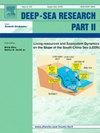印度洋马斯喀伦高原不同纬度造礁珊瑚对印度poillopora indiania和Heliopora coerulea的变光系统II热应力响应
IF 3
3区 地球科学
Q2 OCEANOGRAPHY
Deep-sea Research Part Ii-topical Studies in Oceanography
Pub Date : 2025-02-22
DOI:10.1016/j.dsr2.2025.105467
引用次数: 0
摘要
偏远珊瑚礁地点的持久性始终取决于其珊瑚更好地响应和适应持续的全球环境变化的能力,其方式是保护它们免受因其偏远而产生的额外和直接的压力;这样的珊瑚礁通常被称为珊瑚避难所。本研究调查了印度洋中部马斯克林高原(MP)两种常见珊瑚的纬向热阈值,它们分别来自远离和接近人口中心的珊瑚礁。在26、29和32°C的温度下进行了为期22小时的热实验,重点研究了造礁的同种生物:区域特有的硬珊瑚poillopora indiania,以及在不同程度的偏远和人类影响下(Saya de Malha (SDM)、圣布兰顿(SB)和毛里求斯岛(MAU))的耐热光生理研究不足和受威胁的八珊瑚Heliopora coerulea,每个地点的平均海面温度(SST)都不同。成像脉冲振幅调制(成像- pam)荧光测定法用于确定光系统II (PSII)下的光合作用性能,就有效量子产率而言(ΦPSII),暴露于这些不同的温度制度后。近28 a海温距平增加了1.2°C,在中海带内没有明显的纬度变化。此外,实验结果显示,当珊瑚暴露于32°C (p <;0.0001);来自MAU的P. indiania白化严重(超过90%的表面积),组织脱落程度最高,导致珊瑚死亡,而来自SDM和SB的同生种则表现出较好的光合活性热阈值,分别为23%和33% ΦPSII。相比之下,与来自SDM(48%)和SB(58%)的同株相比,来自MAU的H. coerulea在实验中茁壮成长,显示出最低的位点特异性热阈值ΦPSII(24%)。尽管该研究仅限于光系统II响应,但该研究首次揭示了中山带同类型珊瑚的热脆弱性的纬度变化,并表明来自SDM和SB的珊瑚可能比其他地点的珊瑚更能适应未来变暖事件的影响。本文章由计算机程序翻译,如有差异,请以英文原文为准。
Variable photosystem II thermal stress responses of reef-building corals Pocillopora indiania and Heliopora coerulea across latitudes from the Mascarene Plateau, Indian Ocean
The persistence of remote reef sites invariably depends on the ability of their corals to better respond and adapt to a continuing global environmental change, by way of their protection from additional and direct stressors as a result of their remoteness; such reefs are generally referred to as coral refugia. This study investigated the latitudinal thermal thresholds of two commonly occurring corals from reefs both remote from and close to human population centres, in the understudied Mascarene Plateau (MP), Central Indian Ocean. Thermal experimental trials at 26, 29 and 32 °C for a period of 22h focused on reef-building conspecifics: the regionally-endemic hard coral Pocillopora indiania, and heat-tolerant photo-physiologically understudied and threatened octocoral Heliopora coerulea from three sites of varying degrees of remoteness and human impact (Saya de Malha (SDM), St Brandon (SB) and Mauritius Island (MAU)), each with varying mean sea surface temperature (SST). Imaging Pulse-Amplitude-Modulation (Imaging-PAM) fluorometry was used to determine how the photosynthetic performances at the Photosystem II (PSII), in terms of effective quantum yield (ΦPSII), of the conspecifics responded after exposure to these different temperature regimes. SST anomaly over the past 28 years showed an increment of 1.2 °C with no significant latitudinal variation within the MP. Moreover, the experimental results displayed significant differences in intra- and interspecific ΦPSII when corals were exposed to 32 °C (p < 0.0001); P. indiania from MAU suffered severe bleaching (over 90% surface area), with the highest degree of tissue sloughing leading to coral mortality, while conspecifics from SDM and SB exhibited better thermal threshold by being photosynthetically active, with 23% and 33% ΦPSII, respectively. In contrast, H. coerulea from MAU thrived through the experiment indicating site-specific thermal threshold by displaying the lowest ΦPSII (24%) as compared to conspecific from SDM (48%) and SB (58%). Although limited to Photosystem II responses, this study provides a first insight on the latitudinal variability in thermal vulnerability of conspecific corals from the MP and suggesting that corals from SDM and SB might be more resilient to the impacts of future warming events than corals at other sites.
求助全文
通过发布文献求助,成功后即可免费获取论文全文。
去求助
来源期刊
CiteScore
6.40
自引率
16.70%
发文量
115
审稿时长
3 months
期刊介绍:
Deep-Sea Research Part II: Topical Studies in Oceanography publishes topical issues from the many international and interdisciplinary projects which are undertaken in oceanography. Besides these special issues from projects, the journal publishes collections of papers presented at conferences. The special issues regularly have electronic annexes of non-text material (numerical data, images, images, video, etc.) which are published with the special issues in ScienceDirect. Deep-Sea Research Part II was split off as a separate journal devoted to topical issues in 1993. Its companion journal Deep-Sea Research Part I: Oceanographic Research Papers, publishes the regular research papers in this area.

 求助内容:
求助内容: 应助结果提醒方式:
应助结果提醒方式:


